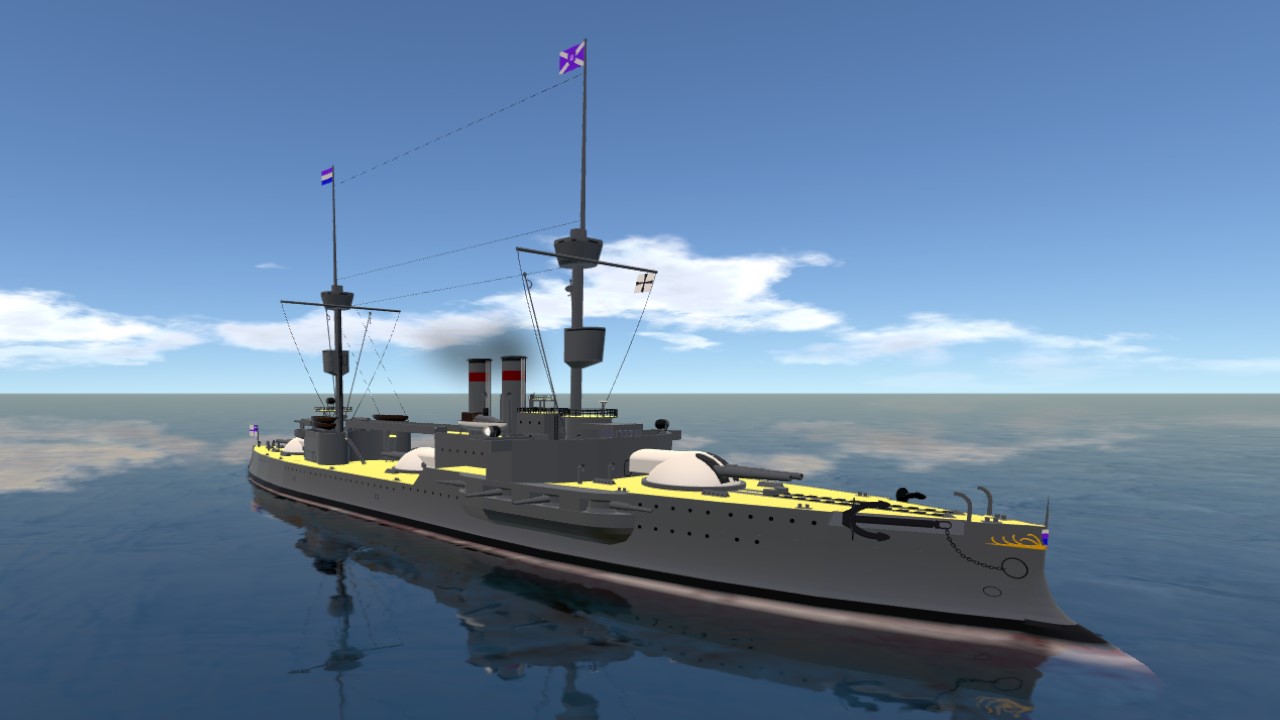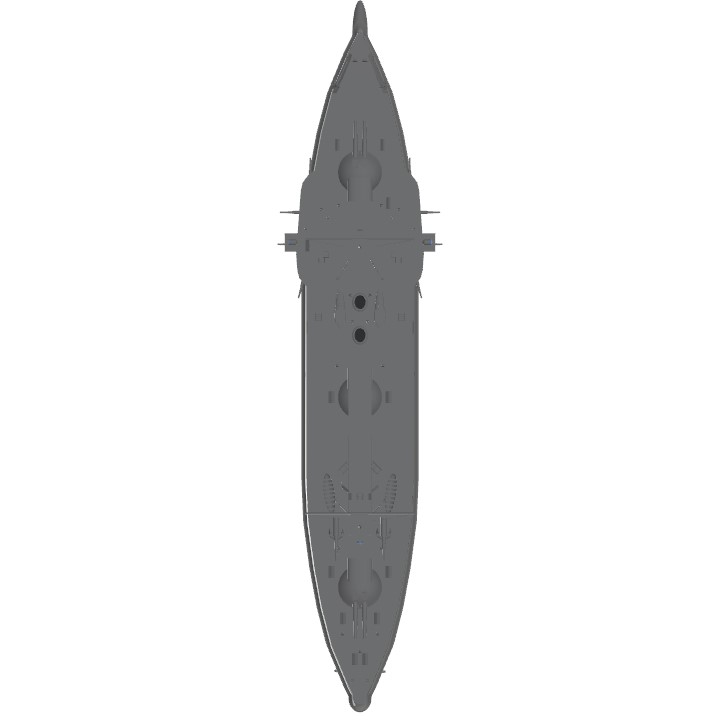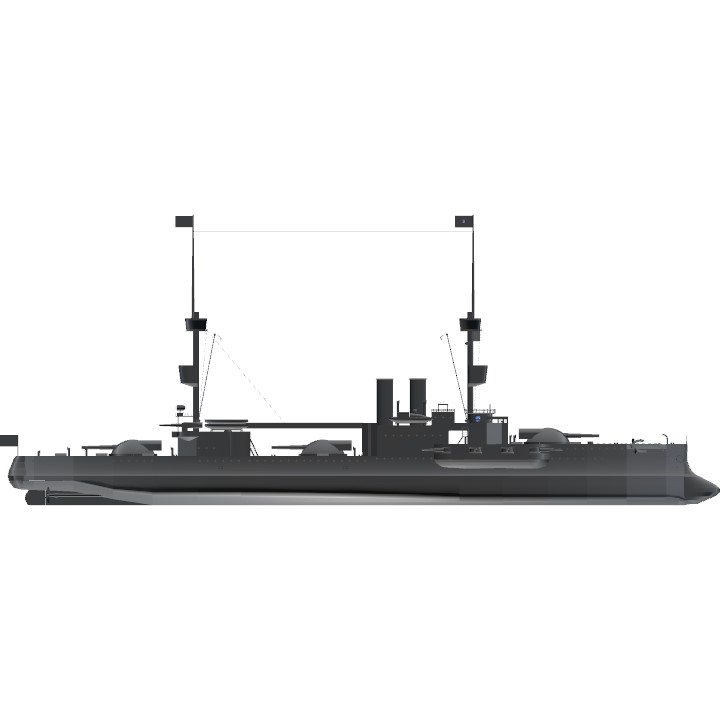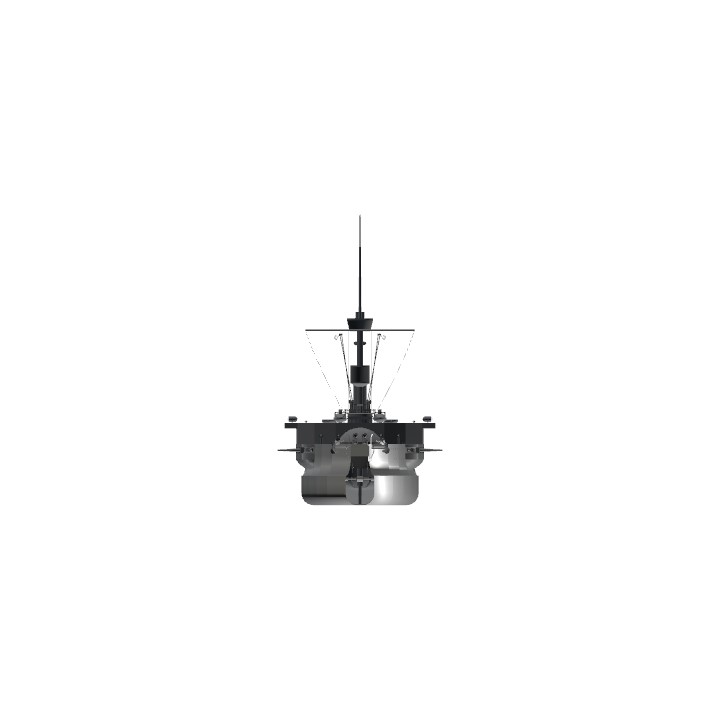KSS Westteich was the lead ship of the Westteich-class pre-dreadnought class battleships, which included Brandenburg, Frieren, Wörth, Kurfürst, and Weissenburg, built for the Sovereign Kaiserliche Marine (Imperial Navy) in the early 1890s and later for the Equestrian Konigliche Marine (Royal Navy). She was the first pre-dreadnought built for the Sovereign Navy; earlier, the navy had only built ironclads, coastal defense ships, and armored frigates. The ship was laid down at Neues Preußen in 1890, launched in 1891, and commissioned into the Sovereign Navy on 1893. Westteich and her five sisters were unique for their time in that they carried six heavy guns instead of the four that were standard in other navies. She was named after the Province of Westteich.
History
Sovereign Empire -> Kingdom of Equestria
Name: Westteich
Namesake: Province of Westteich
Builder: Neues Preußen
Laid down: 1890
Launched: 1891
Commissioned: 1893
Decommissioned: 1920
Status: Museum ship
General Characteristics
Class and type: Westteich-class battleship
Displacement: 10,020 tons tons (Normal), 10,700 tons (Full load)
Length: 123.7 meters
Beam: 28.4 meters
Draft: 7.6 meters
Installed power: 12x marine boilers 10,000 metric horsepower
Propulsion: 2x screw propellers, 2x triple-expansion steam engines
Speed: 16.5 knots
Range: 5,000 nautical miles at 10 knots
Complement;
45 officers
530 enlisted men
Armament;
4x 28 cm (11 in) MRK L/40 caliber guns
2x 28 cm (11 in) MRK L/35 caliber guns
10x 10.5 cm (4.1 in) SK L35 guns
6x 45 cm (17.7 in) torpedo tubes
Armor;
Belt: 400mm (15.7 in)
Barbettes: 300mm (11.8 in)
Deck: 60mm (2.4 in)
Westteich is best known for her role as Heinrich, Graf Wittich's flagship at the Battle of Reit River. She additionally served as Litzmann's flagship at Angriff Islands, Remus' flagship at Mauerland, and Alfred's flagship at Cape Waldersee. She was obsolete by the start of Sovereign Civil War but was heavily used in the Battle of Reit River. After the war, she was effectively withdrawn from service and converted into a museum ship.
Early service
1893 to 1898
This period was generally limited to training exercises and goodwill visits to foreign ports. These training maneuvers were nevertheless very important to developing Sovereign naval tactical doctrine in the two decades before Sovereign Civil War.

Westteich during exercises with her sisters.
First battle of Angriff Islands
In May 1898, Admiral Albrecht Litzmann made Westteich his flagship. Litzmann put to sea from Neues Preußen on 9 July 1898 with a force of around twenty ships, including all of the Wessteichs, and on 26 July, sighted a Dämonisch fleet larger than of Litzmann's 100 miles east of Angriff Islands. The Dämonisch fleet tried to overwhelm Litzmann's force by encircling them but was made difficult by changing winds and driving rain. Litzmann ordered his force to disengage, even though the Dämonisch fleet is having a hard time encircling them, to avoid a close combat. Westteich and her sisters engaged the Dämonisch fleet as they turn around successfully sinking three warships. Westteich returned to Neues Preußen unscathed.

Westteich at Angriff Islands.
Second Battle of Angriff Islands
In March 1899, Westteich's hull was refurbished. On December 2 1900, the ship, still under the command of Litzmann, sailed with the same force reinforced with the two new pre-dreadnought battleships, to annihilate the Dämonisch fleet. Not knowing that the fleet was also reinforced with additional ships, Litzmann ordered an extensive maneuver to avoid getting into close combat while retaining at least 15,000 yards of the battle line. The Dämonisch fleet was almost annihilated with most of their ships sunk. With the Dämonisch fleet retreating, Litzmann ordered his force to disengage.
1901 to 1905
Exercises continued into 1901, and while conducting forced draft tests on 16 February, the ship suffered the worst machinery accident in the history of the Kaiserliche Marine. One of the main steam valves from the starboard boilers exploded, killing forty-four men in the boiler room and injuring another seven. The cause of the explosion was a defect in the construction of the valve. Prinz Heinrich, aboard the nearby transport ship Pelikan, immediately ordered the ship to come to Westteich's aid, and took off the dead and wounded men. Westteich was later towed where she entered the Kaiserliche Werft (Imperial Shipyard) for repairs.

Westteich in 1904
Sentinel Uprising
During the Sentinel Uprising in 1907, Mauerland nationalists laid siege to the foreign embassies in Mauerland and murdered Graf Gottfried von Stein, the Sovereign plenipotentiary. At the time, the primary Sovereign military force in Mauerland was the Expeditionary Squadron I, which consisted of the protected cruisers Konigin Gunthilde, Hansa, and Hertha, the small cruisers Irene and Gefion, and the gunboats Jaguar and Iltis. As a result, the Kaiserin determined an expeditionary force would be sent to Sovereign to reinforce the Expeditonary Squadron I. The expedition included Westteich and her five sisters, six cruisers, ten freighters, three torpedo boats, and six regiments of marines, under the command of Admiral Remus von Equestria.
At the arrival of the Sovereign Fleet, the seige is still on going. The reinforcements soon amde use of their presence. They bombardment key positions in attempt to lift the seige. After a month, the seige was lifted. Westteich took up patrol duties in the surrounding areas and later participated in occupation of coastal fortifications.
A month later, the Sovereign High Command recalled the expeditionary force back to Sovereign Empire.

Westteich and her sisters departing for Maeurland.
Battle of Cape Waldersee
In 1908, Kapitän zur See Leo Kleist and Fregattenkapitän Oskar Richtofen, commanded Westteich under Admiral Aflred von Weizenfeld's flag. In the mid 1908, the Sovereign psotion in Welt 47 had become untenable. Weizenfeld had stationed his fleet off Cape Waldersee to prevent the Rebells from sailing north, whilst Heinrich Wittich was to oversee the evacuation. Once the evacuation had been accomplished, Nelson, in KSS Blücher, sailed for the HQ in Welt 47. On learning that the Rebell fleet had passed by some days previous, Wittich left to rendezvous with Weizenfeld on June 11. The Rebell fleet, which had been suffering for communication blackouts, was that night working its way to Waldersee. The darkness and a dense fog meant Wittich was able to pass through the enemy fleet without being spotted and join Weizenfeld on 13 June. Weizenfeld, whose fleet, had been reinforced on 5 June by five warships (four ironclads and Westteich's sister, Frieren), now had 15 battleships. The following morning, having drawn up into to two columns, Weizenfeld impressed upon the officers on Westteich's bridge how, "Ein Sieg für Equestria ist im Moment sehr wichtig" (A victory to Equestria is very essential at the moment). Weizenfeld was not aware of the size of the fleet he was facing, but at around 0630 hours, received word that five Rebell warships were to the south-east. By 0900 hours, the first enemy ships were visible from Westteich's conning tower, and at 1100 hours, Weizenfeld gave the order to form line of battle. As the Rebell ships became visible to him, Kleist reported the numbers to Weizenfeld, but when he reached 27; Weizenfeld replied, "Genug, Kapitän. Nichts mehr davon. Die Linie wird gebildet und wenn es 50 Schiffe gibt, werde ich durch sie hindurchgehen" (Enough, Captain. No more of that. The line is formed and if there are 50 ships, I will go through them.). The Rebell were caught by surprise, sailing in two divisions, with a gap that Weizenfeld aimed to exploit. The ship's log records how Westteich halted the Rebell squadron, keeping a distance and shooting accurately while Weizenfeld's priavte memoirs recalls how Westteich's broadside so terrified three Rebell warships that they "squared her yards, ran clear out of the battle and did not return". Weizenfeld, realising that the main bulk of the enemy fleet could now cross astern and reunite, ordered his ships to change course, but the rear division failed to comply. The following ships were now in a quandary over whether to obey the Admiral's signal or follow their divisional commander. Wittich, who had transferrd to KSS Frieren, was the first to break off and attack the main fleet as Weizenfeld had wanted, and the other ships soon followed his example. The Sovereign fleet not only achieved its main objective, that of preventing the Rebell from joining their other naval formations at in the channel, but also sunk ten warships. The dead and wounded from these four ships alone amounted to 300 to 500, respectively; more than the total number of Sovereign casulaties of thirteen wounded. Westteich received minimal damage during the battle.

Westteich following Frieren's example.
1908-1910
On her return to Equestria, Westteich and her sisters were assigned to I Squadron. On September 21, the annual fleet maneuvers began; these were interrupted on 30 September when the King of Crystal visited the fleet while on another visit to Equestria. The ships conducted a naval review for his visit. After completing the fleet maneuvers in September and October, Westteich was decommissioned on the end of October. The ship's crew were sent to man the newly commissioned battleship Krauseneck, which took her place in I Squadron.
The political status of the Sovereign Empire is worsening. Following the bloody November Revolution and the December Wonderbolt Secession, the last Empress dissolved the Empire bringing the end of the thousand years old Sovereign Empire.

Westteich in July 1910. She would be reactivated a month later following the outbreak of the Sovereign Civil War.
Sovereign Civil War and Reit Campaign
At the outbreak of Sovereign Civil War in August 1910, Westteich was reactivated and assigned to V squadron, which was initially tasked with coastal defense duties. In mid-September, V was transferred to the mouth of Reit River, under the command of Admiral Heinrich Wittich. By 1912, it is clear to Equestria, Canterlot and Wonderbolt that whoever controls the Reit River can turn the tide of war. Canterlot and Wonderbolt began developing a brown water navy to dominate the Reit. In April 1912, Westteich's sisters we're also reactivated and formed the Fluss Squadron. In early 1913, Westteich was atacked by Wonderbolt torpedo boats and successfully struck her three times. Westteich almost sank but her crew managed to kept her afloat and she returned to the Königliche Werft (former Kaiserliche Werft) for repairs. Westteich returned to the frontlines in later 1913. In March 1914, Westteich and her sisters we're subsequently bombed by Canterlot Airships. From April to June, Brandenburg received her first anti-aircraft weapons, making her the first Equestrian battleship to be equipped with anti-aicraft weapons. Westteich and her sisters followed later. In 1915, following the availability of aircrafts, Westteich and her sisters managed to pinpoint strategic artillery positions and began bombarding them to make way for the Army. In 1916, the Equestrian Army successfully crossed the Reit River and began establishing fortifications on the other side. Westteich and her sisters we're ordered to patrol Reit River in case of any counter attacks.
The war ended in 1920 with Allied victory. Westteich was decommissioned along with her sisters. With her service record, she was saved from scrapping and was decided to covert her to museum ship. Her sisters we're scrapped the following year.

Westteich listing heavily after she got torpedoed.
Controls
- VTOL and Trim to control turrets
- Press the corresponding AGs to activate features
- AG1: Train main guns to starboard, activates starboard secondaries
- AG2: Train main guns to portside, activates portside secondaries
- AG3: Bow torpedoes
- AG4: Starboard torpedoes
- AG5: Portside torpedoes
- AG6: Jet engines in case the propellers failed.
- AG7: Lights
- AG8: None
Notes
This ship does not use any gyroscope type steering. Instead, she uses jet engines to steer. Her steering is quite long and may make the user impatient. Forgive me for that.
Everything written in the story is fictional and does not reflect the real world.
Specifications
Spotlights
- BMilan 9 months ago
- Noname918181818181818181 one year ago
- YarisSedan one year ago
General Characteristics
- Predecessor Pre-Dreadnought Challenge [CLOSED]
- Created On Windows
- Wingspan 93.0ft (28.4m)
- Length 405.8ft (123.7m)
- Height 163.7ft (49.9m)
- Empty Weight N/A
- Loaded Weight 97,177lbs (44,079kg)
Performance
- Power/Weight Ratio 0.721
- Horse Power/Weight Ratio 0.002
- Wing Loading N/A
- Wing Area 0.0ft2 (0.0m2)
- Drag Points 73784
Parts
- Number of Parts 1574
- Control Surfaces 0
- Performance Cost 4,918





Official evaluation
Additional Points (-3, +0):
-3 for not giving credit for the ship's wheel and the anchors
Total: 66
@BMilan Thank you, Sir. I knew I forgot about one thing when I made the description.
Le Pog
Bro just casually created a whole backstory and deep lore around a fictional pre dreadnought battleship💀